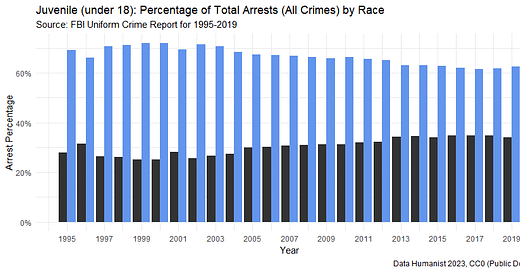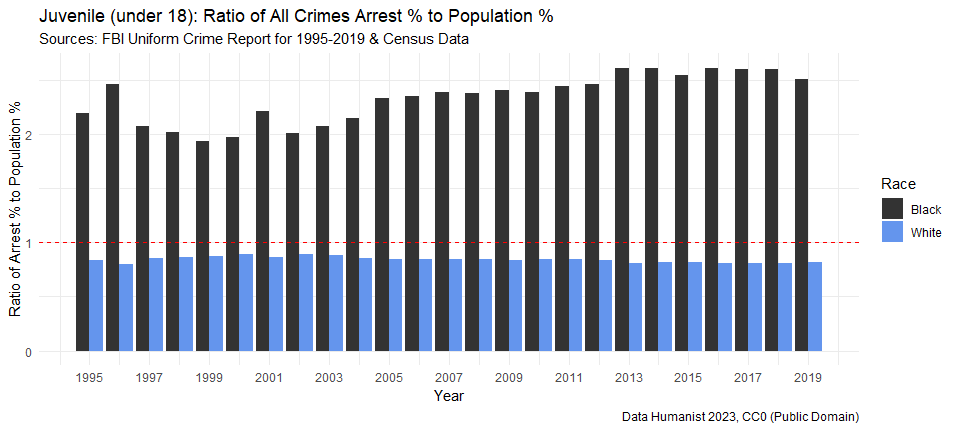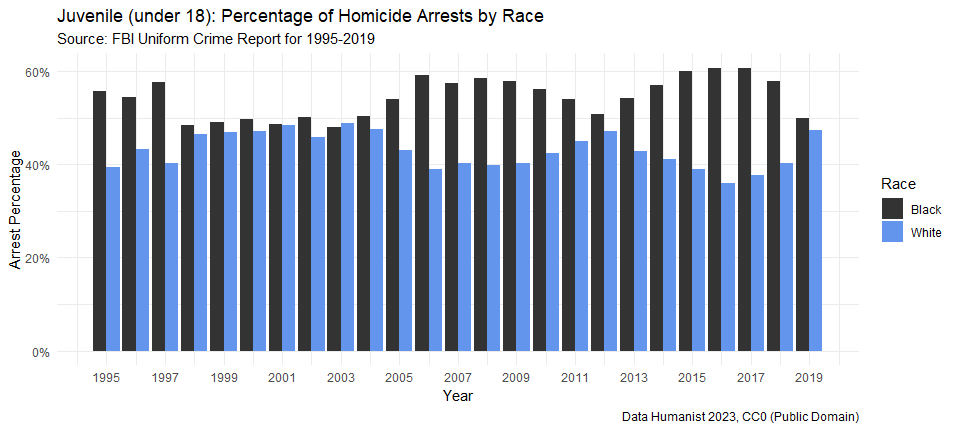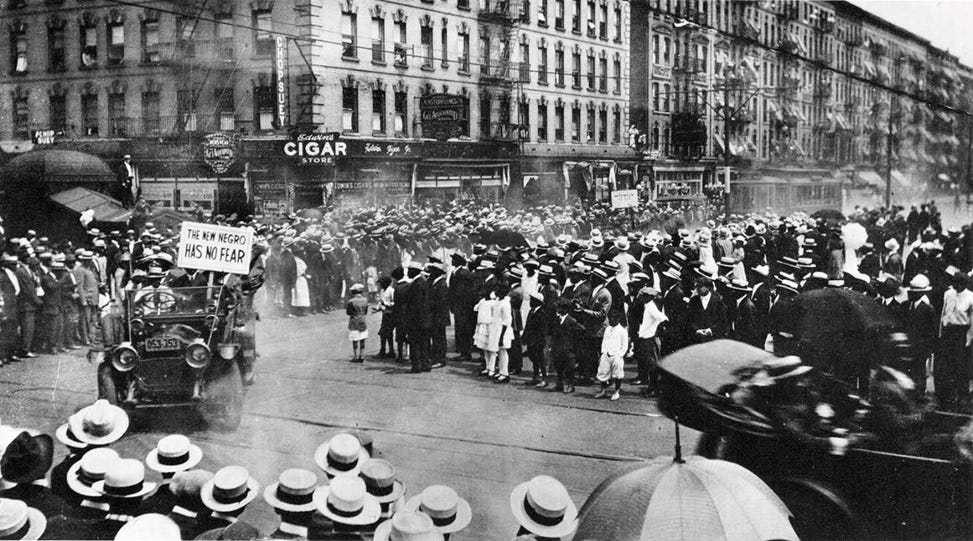Lack of Diversity in American Crime? Part II of II.
Some data-informed reflections inspired by the recent lootings in Philadelphia, Chicago, and elsewhere.
Part II assumes that reader has completed Part I. In the post below, we will NOT review how the FBI categorizes Race in the USA. Nor will we review the simple math behind the data visualizations based on the FBI Crime data. Please see Part I. Moreover, as stated previously, American Exile will use ONLY the government categories and data for this series. We also provide direct links to the original sources: the FBI Uniform Crime Report (UCR), 1995-2019, and the non-partisan USAFacts.org: Our Changing Population, which uses USA Census Bureau data. That is, crime data from the FBI; population data from the Census Bureau via USAFacts.org.
In addition, as is our standard practice, we provide a Github repo with the code and data sets used to produce the visualizations and any related statistical analysis. Again, as always, any data analysis done by Data Humanist for American Exile offers complete transparency and reproducibility.
As a final introductory disclaimer, to keep the graphs readable and uncluttered, once again we will focus on the two primary races in terms of both population size and arrest frequency: White and Black (aka, Black and African American). As identified by the FBI, these two races typically account for greater than 93% of all annual arrests. For questions about how the FBI understands the American Hispanic and/or Latino communities in terms of Race, please see Part I. For more on the other four race categories used by the FBI — American Indian or Alaskan Native, Asian, Native Hawaiian or Other Pacific Islander, and Unknown Race, please see Part I. Thank you.
American Juvenile Crime in Black and White, 1995-2019
The FBI defines juvenile crime when the offender is under the age of 18. Based on the FBI: UCR for 1995 to 2019, the graph below shows the juvenile crime arrest percentage for all crimes as broken down by the two primary races in terms of both population size and arrest frequency: White and Black.
To no surprise, more white juveniles are arrested annually than black juveniles as the general White population as categorized by the FBI is considerably larger than the general Black population as categorized by the FBI.
Similar to what we did in Part I, we can scale the annual Arrest % as simple ratio to annual Population %. But for the Juvenile crime data, this comes with a caveat. We are comparing the juvenile population of each race group as identified by the FBI against the total population of each race group as identified by the FBI. For the period under consideration, the age demographics within the White population and the Black population are roughly equivalent — but not exactly so. Unfortunately, your author does not have good figures for juvenile population break per year — so we are stuck with the general population figures.
Scaled — but note above qualification
The graph below scales the Juvenile crime data Arrest % as a simple ratio to the general Population %.
For the time period under consideration, juveniles of the Black race as identified by the FBI were twice as likely to be arrested as their juvenile White counterparts. This pattern is largely similar to the pattern shown in the scaled graph from Part I for All Ages — All Crimes, which your author will reproduce below.
All Ages — All Crimes Scaled
The overall trends are largely similar to those shown in the Juvenile data. Please keep in mind that the All Ages — All Crimes data contains the Juvenile data, so this helps account for some of the similarities.
Disproportionate Juvenile Black Criminality
Based upon the best available data, we have undeniable evidence for disproportionate Juvenile black criminality. But does the “All Crimes” data really matter? What crimes? How serious?
Once again (similar to Part I), let’s run the data for Murder and Nonnegligent Manslaughter — aka, Homicide. The following graph is restricted to the Juvenile population.
Juvenile Homicide, 1995-2019
Once again, the bad news here is irrefutable. For twenty-three of the twenty-four years covered, juveniles of the Black race as identified by the FBI were the majority arrestees for homicide — for Murder and Nonnegligent Manslaughter, to use the formal FBI category. That is, even without accounting for differences in population size, a greater number of young Black Americans than young White Americans were arrested for homicide.
Scaled with qualification
Let’s scale the juvenile crime data arrest % according to the general population %, acknowledging the qualifications discussed earlier.
The pattern is horrific. Worse than the scaled All Ages— Homicide data visualization from Part I, which found that for the twenty-four-year time period under consideration, people of the Black race as identified by the FBI were on average 6.72 times more likely (with a standard deviation of 0.74) to be arrested for homicide than their White counterparts. Your author will not provide a ratio average here as the Juvenile scaling is necessarily more imprecise.
But perhaps a quote from 2Pac’s 2004 song, “Thug 4 Life,” will add some context:
What does it take to be a G?
Silence is a must, violence is a plus
Bust shots at my adversaries, them niggas scurry
Pick a spot to be buried, ‘cause I'll be buckin' in a fuckin' hurry
When juvenile Black Americans commit homicide, the victims are primarily other juvenile Black Americans. One could for whatever reasons glorify and hence normalize this — as the late 2Pac did in the above song “Thug 4 Life” (elsewhere he was more critical). Or one can understand the juvenile Black homicide epidemic as a multi-generational, ongoing national tragedy.
Possible Root Causes and Contributing Factors
Let us return to the conversation by Professors Loury and McWhorter (Sept 11, 2023), which was previously discussed in Part I. In coming to terms with juvenile crime in Chicago, both men explicitly compare the Black community since 1960 with that prior to 1960. Because of the now-standard MSM narrative that Black American are perpetual forever victims of White racism and the historical effects of slavery, many Americans do not know that Black Americans had for decades thriving working-class and middle-class communities with property and business ownership, generally stable family structures, and rather more.
A History Lesson
McWhorter engaged this now-abandoned history in his Authentically Black: Essays for the Black Silent Majority (2003). Starting in the late 19th century, McWhorter (2003) noted, “American cities typically had thriving black business districts reproducing white America down to the last detail, including excellent schools — Bronzeville, Chicago; the Auburn Avenue district in Atlanta; the Shaw district in Washington, DC; even Harlem before the 1940s.”
Indeed, Harlem, NYC, during the 1920s and 1930s was a national center for black entrepreneurship, politics, scholarship, art, literature, music, dance, and theatre — a flourishing known as the Harlem Renaissance. The photo below (Public Domain) is from a Universal Negro Improvement Association parade in Harlem, 1920. It shows a clean, thriving community. The crowd seems dressed in what we used to call the “Sunday best” — the people are clearly engaged but also highly civil and respectful of each other. No drive-by shootings here. One sign reads “The New Negro has No Fear,” referencing the New Negro Movement which began in 1917, and which reached international recognition by the mid-1920s with the publication of Professor Alain LeRoy Locke’s anthology The New Negro: An Interpretation (1925).
It might be worth mentioning that Professor Locke, a Dean-like figure and mentor to the Harlem Renaissance, graduated from Harvard University with degrees in English and Philosophy; was honored as a member of the Phi Beta Kappa Society; was a recipient of the Bowdoin prize; and was the first Black American to be selected as a Rhodes Scholar to the University of Oxford. Please keep in mind that Locke accomplished all this decades before the Civil Rights movement.
Harlem was by no means the only example of a thriving Black American community. In False Black Power? (2017), Jason L. Riley has discussed numerous examples. For one, let’s head back to Chicago. As Riley (2017) has uncovered:
According to a business directory, there were already around two hundred black businesses operating in twenty-seven different fields in Chicago alone by 1885. A history of the city’s black Bronzeville neighborhood noted that the “rapid growth of the Negro community between 1915 and 1929 was accompanied by expansion in all types of Negro-owned businesses,” from beauty salons and groceries to banks and insurance companies. “In 1938, Negroes in Bronzeville owned and operated some 2,600 business enterprises,” most of which were small retail and service outfits catering to people in less desirable communities. [Source cited in-text by Riley: Ronald W. Bailey, ed., Black Business Enterprise: Historical and Contemporary Perspectives (NY: Basic Books, 1971), 64–65].
Prior to the 1960s-1970s, we have numerous examples of thriving Black American communities with Black-owned businesses, stable family structures, and vibrant cultural and social activities. All this accomplished while Black Americans suffered variously under legalized segregation, Jim Crow laws, and other forms of outright racial discrimination.
So what happened? How, for example, did Chicago become such a mess? (Or Philadelphia, et cetera). How did Chicago’s young Black people become so lost?
Three Overlapping Factors
Professors Loury and McWhorter (Sept 11, 2023) hash out a few overlapping claims.
First, deindustrialization undoubtably wiped-out entire job categories in a which a single wage-earner without an advanced education would still be able to afford housing, get married, and support a family. But these changes — which started in the 1970s and accelerated greatly during the Reagan-Bush presidencies — impacted working class Americans as a whole and not just Black Americans. Hence the economic explanation is not sufficient.
Second, both men point to rise of absentee fathers in black households as having a devastating impact on the socialization of black youth.
Third, both men seem to agree that the black underclass now suffers from a culture of expectation and entitlement rather than a sense of entrepreneurship and self-reliance. McWhorter (Sept 11, 2023) pointedly states: “I think it was a whole cultural mood where you were trained to think about Society owing you something — rather than making the best of the worst.”
Your author understands this as learned helplessness — we now have an entire American generation across races and ethnicities being indoctrinated at the K-12 level that they must rely upon the government (the Administrative State) for everything. Take no action on your own, just learn and fulfill your assigned role according to our Intersectionality Matrix.
The Great Cultural Retrogression
That aside for now, what changed during the 1960s and 1970s? The Civil Rights movement made real and necessary historical gains. Legalized segregation was evil and so finally ended. So after all of these legal and political gains, why did many Black American communities regress? To the remarks above by Loury and McWhorter (Sept 11, 2023), we add again the insights of Jason Riley (2017):
In the postslavery era, the differences in black progress before and after the Great Society interventions are glaring. When intact families were commonplace, the rise in black education, incomes, and occupations was significant and steady. As black family disorganization intensified and wealth-transfer programs grew in size and scope, that progress slowed in some cases and stalled in others. Liberals have attempted to compensate for black cultural retrogression since the 1960s with increased black political power.
What happened — starting in the late 1960s and kicking in strongly during the 1970s — were the Great Society interventions. The Black working class increasingly became the Black welfare class, dependent on government transfer-payments. Single motherhood received not just economic support, but economic incentives. Fatherhood became increasingly abandoned. The Black middle class bifurcated — the section that stagnated became tied geographically and economically to the now Black underclass. In many Black urban communities, the explosion in violence and criminality became normalized as a matter of survival. Then perversely, but perhaps understandably, it became for many young black people a matter of identity. For one example, we cited earlier 2Pac’s song “Thug 4 Life” (2004).
What Could Be Done Vs. What Will (Likely) Be Done
The juvenile Black homicide epidemic is a multi-generational, ongoing national tragedy. The property crimes which Loury and McWhorter (Sept 11, 2023) discuss are part of the larger problem to which the homicide epidemic belongs, but these destructive acts of large-scale retail theft should not take priority over the daily murdering of young Black people by other young Black people.
To turn this around, we would need to overhaul the Welfare system and effectively end most of the Great Society interventions. Particularly, we must end the economic and benefit incentives for single mothers to have more children.
We would need to reclaim if not also valorize fatherhood. This seems improbable given the current MSM and academic war against masculinity, but to cite from the National Responsible Fatherhood Clearinghouse, research shows that “children with involved, loving fathers are significantly more likely to do well in school, have healthy self-esteem, exhibit empathy and pro-social behavior, and avoid high-risk behaviors including drug use, missing school, and criminal activity” (retrieved Oct 5, 2023).
We would need to re-invent if not replace if Public Education. Take Chicago, for one example. As Hannah Schmid has reported (Dec 12, 2022): “Nearly 80% of Chicago Public Schools students cannot read at grade level. Just 15% met proficiency in math.” Take Philadelphia, for another example. As Reagan Reese (May 9, 2023) has reported: “Only 17% of third through eighth grade students met math grade level expectations in the 2021-2022 school year" and only "34% were proficient in English in the 2021-2022 school year.” These young people are qualified for a future in what?
We would also need to change the culture of victimhood and entitlement and end the glorification of black-on-black violence. All this to start.
Neither the Political Will Nor Leadership
To attempt serious change in any of these dimensions means directly taking on the Democratic Party leadership (DNC) and many of their core supporters, including the Teacher Unions.
If the Democratic leadership must choose between its own destruction and the ongoing destruction of Black America, the choice is obvious — it is one the Democratic leadership has already made, confident in their ability to still secure roughly 90% of the black vote for every national election regardless of how much Black America suffers. The past six decades provide eloquent testimony to the efficacy of this strategy. On the Republican side, and at the very top we have a Uni-Party anyway, no Republican leaders seem to have either the will, the clout, the incentive, or necessary combination thereof to hold their Democratic colleagues accountable for now three generations of failure in both policy and practice.
So what will likely happen is nothing positive — the situation will continue to deteriorate. This serves the interests of our donor class, our bicoastal elites, and the Uni-Party. How so?
Anarcho-Tyranny, Neo-Feudalism, and the Great Reset
Let’s circle back to the property crimes, the looting and large-scale retail theft which Loury and McWhorter (Sept 11, 2023) sought to explain the root causes for, and which McWhorter specifically claimed were “a black thing to join up in a gang like that and to tear everything up for no particular reason.”
In fact, MSM pundits and celebrities have offered no shortage of justifications —massive shop-lifting rampages as a form of political protest, to start. Trevor Noah, for one celebrity race pundit, famously excused incidents of looting during the year of “Mostly Peaceful Protests.” The participants themselves in these events have also — this captured on video on numerous occasions — provided a rationale: reparations. The property crimes are justified as compensation or payback. As reparations.
Juvenile Black Crime and Identity Culture Wars
We now have looting and wide-scale retail theft as part of identity politics, and hence explained by some on the Left as form of political performance — an alternative means of civic engagement. In this context, the criminal behavior by Black American juveniles is merely part of the larger “identity culture war” — a divide and conquer campaign, which as Ungar-Sargon (2021) has astutely claimed, portrays “our nation as hopelessly divided along partisan and racial lines” while serving “as a smoke screen for the actual impenetrable and devastating division that is happening along class lines.” (For more on this concern, please see our earlier Six Notes on Neo-Feudalism).
This serves the interests of our donor class and our bicoastal elites because they seek to replace our Constitutional Republic with a Neo-Feudalistic Administration State. The politicized urban crime discussed above serves the valuable purposes of creating anarchy, undermining working class and middle-class communities, destroying small businesses, and helping to dismantle brick-and-mortar retail more generally. All this has a polarizing effect on American society, working also to undermine civil institutions and public trust in governance.
For a much more in-depth study of these general concerns, please read the following.
The American Un-Civil Wars to Come: Lessons from Africa in Our Time
Talk of an American Civil War is fashionable if not pervasive. A recent (2022) study by the Violence Prevention Research Program at University of California, Davis found that half (50.1%) of the people surveyed agreed that "in the next few years, there will be civil war in the United States." Major policy and opinion influencers such as the billionaires…
What is good for Amazon may not be good for the nation.
Do Our Elites Really Not Care?
For people whom have no experience dealing with the donor class and/or our bicoastal elites, it will seem shocking that they would not just turn a blind eye to what is now a multi-generational juvenile Black homicide epidemic, but that they would exploit the same to their political advantage.
But what almost universally unites our elites and the European WEF globalists are the twin convictions that there are just too many people on planet earth, and that progress on Climate Change and other goals will require sacrifice. Just not by them —but by the masses. Our donor class and bicoastal elites must remain in positions of power and privilege at any cost (not paid by them) — for the greater good, of course.
Sarah Chayes (2021), a globally recognized expert on kleptocracies, brings the general situation home in two sentences:
In an examination of seven anticorruption insurrections on five continents, the tactic I found to be most common — and most effective — was to deliberately enflame identity-based divisions that could pit groups of the population against one another. This is how a vastly outnumbered dominator coalition defeats the rest of us.
This is where we are at. The USA is already in a state of low-intensity, low-simmering Civil War. But think more like the former Yugoslavia before the break-up — and not like 19th century USA, with blue and grey uniforms. Black youth are being used as cannon fodder to keep the American kleptocrats in power at the expense of the general American public. Understanding this and saying so will cause you to be denounced as a racist. Feel free to unsubscribe. But also feel free to share.











As one ponders the state of affairs, try to remember how many times you’ve heard the tagline “War on ___” or the flip side of the same coin, “Safeguarding ___”.
Be it poverty, drugs, terror, disease, disability, women, children, the vulnerable/oppressed...no matter what the government says/does the situation expands, and worsens.
The USA has been at war since its inception; if a foe is not available, then it is manufactured.
You call them ‘power elites’; another calls them the ‘banker anthropologists.’ They make the money; they conjure busts and BOOMS!We are manipulated and enslaved. Television. This mini-super computer in my hand. Hollywood. 9/11. Soros’ DA’s. The 6 major outlets of info. MK Ultra in family friendly drag story hours. Shoot, why not loot!
Already linked Part 1 will be linking this one today @https://nothingnewunderthesun2016.com/